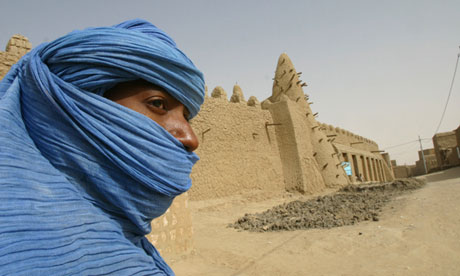There is an old African proverb: "When two elephants fight, it is the grass that suffers." Once again in its 800-year history, the fabled city ofTimbuktu, a Unesco world heritage site, and its rich intellectual and literary heritage are under threat from both the marauding rebel groups that now occupy the desert cities of northern Mali and the foreign troops marshalled to "liberate" it from them.
Today Mali is well known among many people in the west for its famous musicians: the likes of Ali Farka Touré; the Grammy award-winning singer Oumou Sangaré; the pop singer-songwriter Salif Keïta; andTinariwen, to mention only these few, are loved and revered by music lovers across the world. However, they represent only part of Mali's oral tradition. What many people may not know is that Timbuktu and other desert cities of Mali are also home to hundreds of thousands of Africa's most treasured ancient manuscripts dating back to as early as the 11th century and covering disciplines as diverse as mathematics, astronomy, medicine, grammar, agriculture, poetry, rhetoric, law, politics, philosophy and theology.
Most of the manuscripts predate the arrival of Europeans on the African continent and are in classical Arabic, which at that time was to west Africa what Latin was to Europe, the lingua franca of the educated elite. This is significant because western philosophers such as David Hume in a footnote to his 1748 essay Of National Characters and Immanuel Kant in Observations on the Feeling of the Beautiful and Sublime, published in 1764, had tried to argue that black people were inferior to white people because they possessed no literary culture and that their history was transmitted only through oral means. Even modern scholars obsessed with the need to substantiate Milman Parry's assertion in the first half of the 20th century that Homer's Iliad and Odyssey were oral compositions try to do so by looking for examples of "improvised oral composition" from so-called "illiterate oral cultures" in Africa and other regions. Thanks to the rediscovery of ancient African manuscripts in Mali, Ghana, Nigeria and some parts of Africa we can now prove that African societies indeed had thriving literary cultures that enabled them to transmit their histories through both written and oral mnemonic systems.
At about the same time that the oldest universities in the English-speaking world, Oxford and Cambridge, were established, Timbuktu was a thriving intellectual city of more than 20,000 scholars, a "university" or two, and hundreds of libraries. Timbuktu represents one of the "golden ages" in Africa's history. Its surviving manuscripts are our door into that golden past. Leo Africanus (also known as al-Hasan ibn Muhammad al-Wazzan) visited Timbuktu at the beginning of the 16th century and wrote about its abundant gold wealth and many libraries in his famous bookDescription of Africa. The book was originally written in Arabic and it was Pope Leo X who commissioned the Italian version. It immediately became a bestseller in Europe – some think it was a 17th-century translation of this book that may have inspired Shakespeare's construction of Othello.
The invasion of Timbuktu by marauding Moroccan armies who deported and killed its scholars and destroyed some of its libraries in 1591 brought Timbuktu's golden age to an abrupt end. Surviving scholars and residents managed to hide some of the city's precious manuscripts in cow or goat skins underground. They were then passed on within families from one generation to another. When Mali came under French colonial rule the manuscripts were presented with yet another threat. It was only decades after Mali's independence in 1960 that some families in Timbuktu began to allow outsiders access to their treasured manuscripts.
Until the latest Mali crisis, the Timbuktu manuscripts were being preserved and catalogued in a multimillion-dollar state-of-the-art library and research centre in Mali built by the South African government, thanks to then President Thabo Mbeki's passion for and direct involvement in the restoration and preservation of the manuscripts through the South Africa-Mali project. The New Partnership for Africa's Development (Nepad) – an economic development program of the African Union, the University of Cape Town, and the New York-based Ford Foundation, have also invested a lot in the Timbuktu manuscript project.
For the past few years I have been volunteering to teach and mentor black and minority ethnic pupils from state schools at the University of Cambridge's annual summer schools aimed at encouraging such students to apply to Cambridge. I have always used the opportunity to introduce them to the Timbuktu manuscripts and their significance to black intellectual history. After each lecture, pupils tell me that they feel both a sense of wonder that they have not been previously exposed to this information and also great pride at learning that their histories and identities are not defined purely by slavery. Sadly, this rich repository of Africa's intellectual history is now under a greater threat than any it has faced before

No comments:
Post a Comment